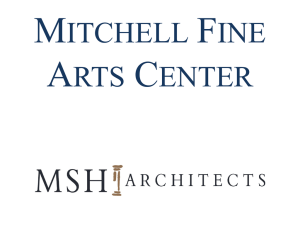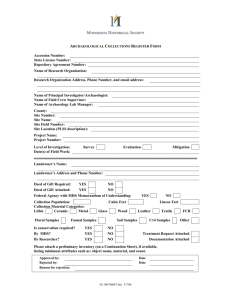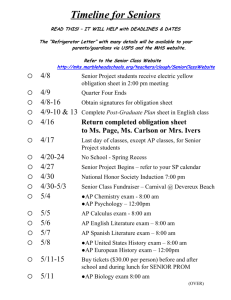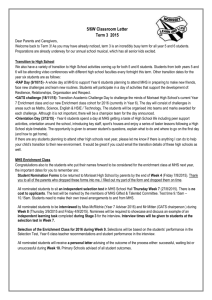The MHS program review was conducted in March of 2015.... consisted of 2 internal (Dr. Pat Morse and Dr. John... Master of Health Sciences (MHS) Program Review Recommendations
advertisement
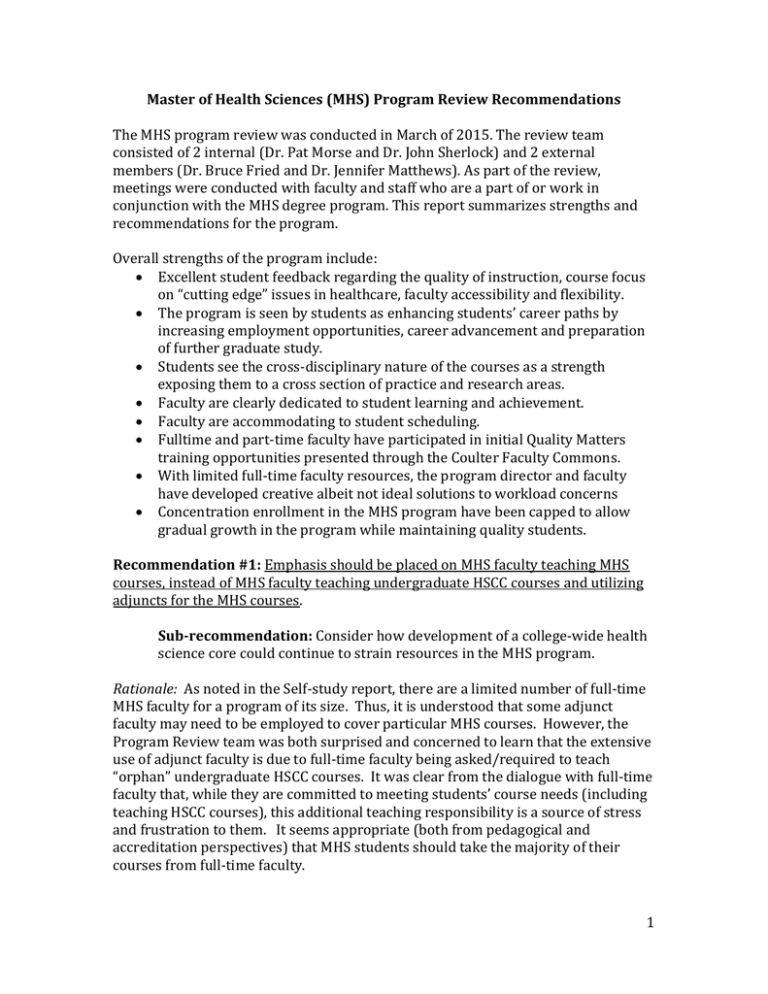
Master of Health Sciences (MHS) Program Review Recommendations The MHS program review was conducted in March of 2015. The review team consisted of 2 internal (Dr. Pat Morse and Dr. John Sherlock) and 2 external members (Dr. Bruce Fried and Dr. Jennifer Matthews). As part of the review, meetings were conducted with faculty and staff who are a part of or work in conjunction with the MHS degree program. This report summarizes strengths and recommendations for the program. Overall strengths of the program include: Excellent student feedback regarding the quality of instruction, course focus on “cutting edge” issues in healthcare, faculty accessibility and flexibility. The program is seen by students as enhancing students’ career paths by increasing employment opportunities, career advancement and preparation of further graduate study. Students see the cross-disciplinary nature of the courses as a strength exposing them to a cross section of practice and research areas. Faculty are clearly dedicated to student learning and achievement. Faculty are accommodating to student scheduling. Fulltime and part-time faculty have participated in initial Quality Matters training opportunities presented through the Coulter Faculty Commons. With limited full-time faculty resources, the program director and faculty have developed creative albeit not ideal solutions to workload concerns Concentration enrollment in the MHS program have been capped to allow gradual growth in the program while maintaining quality students. Recommendation #1: Emphasis should be placed on MHS faculty teaching MHS courses, instead of MHS faculty teaching undergraduate HSCC courses and utilizing adjuncts for the MHS courses. Sub-recommendation: Consider how development of a college-wide health science core could continue to strain resources in the MHS program. Rationale: As noted in the Self-study report, there are a limited number of full-time MHS faculty for a program of its size. Thus, it is understood that some adjunct faculty may need to be employed to cover particular MHS courses. However, the Program Review team was both surprised and concerned to learn that the extensive use of adjunct faculty is due to full-time faculty being asked/required to teach “orphan” undergraduate HSCC courses. It was clear from the dialogue with full-time faculty that, while they are committed to meeting students’ course needs (including teaching HSCC courses), this additional teaching responsibility is a source of stress and frustration to them. It seems appropriate (both from pedagogical and accreditation perspectives) that MHS students should take the majority of their courses from full-time faculty. 1 Recommendation #2: Determine long-term plan of the program. This includes a strategic plan and sustainability of a graduate program built on fixed term faculty rather than tenure/tenure-track faculty. Rationale: While the current faculty are more than willing to ensure student needs are met, the program needs to determine where they see themselves in 5 years or more. Specifically, how does the program identify? Do they want to remain as is, or do they want to increase the number of tenure/tenure-track faculty teaching within the program? Have the faculty considered transforming the program into an MPH degree? The MPH is very marketable within public health and might appeal to a broader audience than the current MHS. However, enrollment in the MHS does not appear to be a concern of the program. A MPH program may also attract more external grant funding opportunities. A strategic plan becomes more important with the changes to the nutrition field. According to the faculty, entry-level requirements for a registered dietician will be with a masters degree, with this change occurring in the next 10 years. With nutrition being one of the concentrations within this program, it is imperative that a long-term plan is made to account for this field-driven change. Sub-recommendation #1: Continue to implement the Advisory Committee. Rationale: The Advisory Committee is currently in progress. We encourage the faculty in the MHS program to continue developing this committee to allow for outside perspectives into the degree program. Sub-recommendation #2: Reexamine five MHS program outcomes presented in the self-study and ensure the program is actively assessing all outcomes. Rationale: Evidence of the MHS program outcomes being assessed was limited during the program review. We recommend reexamining the current outcomes to ensure they are appropriate for all concentrations. Additionally, moving to a competency model for outcomes is recommended. Once these outcomes have been reexamined, we recommend that a plan be established for regular assessment. Recommendation #3: Reexamine and evaluate effort spent on student research projects considering limited resources within the MHS. Rationale: Student research projects are clearly a strength of the program. They provide an opportunity for students to delve into specific issues of interest, and to understand the challenges faced in developing a research question, designing suitable research methods, and carrying out the research. They also provide an opportunity for students to work closely with a faculty member and to benefit from this mentorship. Some projects have led to publications and presentations at professional meetings; these are beneficial both to the faculty member and the 2 student. It is a credit to students’ research and faculty members’ support of their research that several projects have led to significant changes in client organizations. Notwithstanding the value of research projects, it was apparent in our discussions that these research projects required a substantial amount of faculty time, and in some instances, has placed a strain on faculty members’ time and resources. It is important to assess how student projects are currently conducted to determine if there are alternative ways to structure the research projects. Among the possibilities: Restructure individual projects into team projects. Advantages of this include reducing the number of research projects that have to be supervised, providing an opportunity for students to learn from each other, and enhancing students’ competencies in working on a team. Reassign research projects to fewer faculty members and concurrently achieve efficiencies in supervision. It might be possible for one or two faculty members to take on all of the research projects, assuming that time could be freed up from other obligations. It is possible, for example, that some faculty members have particular interests and competencies in project supervision, and who may be willing to serve as research project supervision specialists. Alternatively, responsibility for project supervision might be assigned on a rotating basis. Engage adjuncts and others as supervisors or co-supervisors of research projects. This could potentially alleviate some of the time pressures on faculty members supervising multiple projects. It is important as well to place research project supervision in the context of overall faculty workload. While it is difficult to compare the time requirements of teaching a course versus supervising a research project, dialogue about larger questions of faculty workload may be helpful. Recommendation #4: Enhance engagement of adjunct faculty members in MHS program activities (i.e. faculty meetings, curriculum development, program assessment). Rationale: While adjunct faculty are invited to faculty meetings, few attend, but the MHS program’s heavy reliance on adjuncts, they need to be more engaged in regular dialogue addressing and informing program issues. Additionally, implement peer evaluations of adjunct faculty to ensure quality of instruction across the curriculum. Currently, the only mechanism to evaluate adjunct teaching is through Student Assessment of Instruction (SAI) evaluations. The addition of peer evaluations will strengthen program fidelity by providing constructive feedback to adjunct faculty and by providing continuity to the overall program goals and objectives. Similarly, while full-time faculty have participated in the initial “Quality Matters” training to enhance their online teaching, adjunct faculty have not therefore, it is recommended 3 that adjunct faculty attend training and fully implement the “Quality Matters” instructional program. Recommendation #5: Consider the following changes to MHS curriculum content: Health Management Concentration: 1) Leadership Strategies, 2) Epidemiology, and 3) Healthcare Quality courses should be required by all students in this concentration, rather than listed as an option from the listed concentration classes. Health Education Concentration: 1) Theoretical Foundations of Public Health (MHS 530), 2) Program Planning and Evaluation (MHS 538), and 3) Principles of Epidemiology (ENVH 570) be required for all students in the health education concentration. Consider Epidemiology course a part of the Core Courses for the MHS degree. Consider a combined Epidemiology/Biostatistics course Rationale: Based on the external reviewers’ experience with graduate health science programs, these recommended curriculum changes better align the MHS curriculum with other similar high quality programs. Specifically related to the health education concentration courses, these changes reflect the content students will see on the Certified Health Education Specialist (CHES) exam. Recommendation #6: Improve documentation of students’ career after completion of the program. Many faculty indicated informal tracking of alumni, but to date, no formal process is in place. Rationale: Many faculty members indicated that the program informally tracks alumni, but to date, no formal process is in place. We recommend that the program works towards a formal system of tracking, potentially in the form of developing an alumni database. A well organized, accessible, and current alumni database potentially serves multiple purposes including: Providing a mechanism for tracking student progress in their careers Evaluating program alignment with the demands of the job market Maintaining contact with alumni Utilizing interested alumni for program-related activities In collaboration with alumni, developing a strategy for student recruitment Serving as mentors for current students Engaging alumni in strategic planning efforts Connecting students with the field of practice With respect to alumni interest in getting involved in an academic program, we often see segmentation into multiple groups: (1) marginally interested, (2) interested if given a specific role (e.g., guest speaker in a class), and (3) potential alumni leaders. Targeting potential alumni leaders can yield multiple benefits to 4 the program, including the possibility of, over time, establishing an alumni association. Related to career tracking is the importance of connecting current students with relevant regional, state, and national organizations and associations. Health management students, for example, should be encouraged to join such associations as the American College of Healthcare Executives (ACHE) as student members, the Medical Group Management Association, and the National Association of Health Service Executives (NAHSE). There is a Charlotte Chapter of ACHE, which lists Jackson County in its territory. Participation in professional associations provides opportunities for students to learn and to develop their professional identity. Recommendation #7: Address lack of diversity among faculty and students by developing a diversity recruitment and retention plan for faculty and students in collaboration with the School of Health Sciences, the College of Health and Human Sciences and the University. Additionally, ensure that coursework addressing diversity and difference is included in course content, with either a specific course on diversity or by embedding material on diversity and difference into current courses across the curriculum. Rationale: The MHS program learning environment can be strengthened and enhanced by demonstrating a commitment to diversity and difference—including consideration for diversity of age, class, color, culture, disability, ethnicity, gender, gender identity and expression, immigration status, political ideology, race, religion, sex, and sexual orientation. Recommendation #8: Promote the Certified Health Education Specialist (CHES) exam to students in the health education concentration. Rationale: While CHES certification isn’t required to practice in the health education field, more businesses are looking for individuals with the CHES credential. With many of the changes from the Affordable Care Act highlighting the need for health education specialists, the credential could provide an advantage to individuals during the application process. Additionally, it furthers the profession of health education and certifies graduates of the MHS program have a certain knowledge base. Recommendation #9: Clarify admissions criteria and metrics. Rationale: Established criteria for admission is not straightforward. Professional programs often find that traditional criteria (e.g., GPA, GRE) do not predict success in the program, or success in their field of practice post-graduation. In our discussions with faculty, several noted the importance of writing skills, and deficiencies in this area among some students (this is a common criticism across the US). Written and oral communication skills, as well as such “soft” skills as 5 teamwork and presentation skills, can be viewed as criteria for admission, and/or a professional development area for current students. It would be helpful to engage in an inclusive exercise to identify relevant and proven admissions criteria and other metrics (e.g., matriculation rate, success in the job market). We recommend broad involvement in such a process, and should optimally include faculty, current students, former students, and potential employers. A relatively easy initial task would be to assess the predictive validity of current admissions criteria. That is, it should be possible to assess how well current admission criteria predict success in the program, and success in the job market. A mix of empirical data and key informant information (e.g., employers) can help the program establish the most critical criteria for admission, and perhaps place less emphasis on other factors. In the long term, the sustainability of the MHS program depends upon the quality of its students and their eventual professional success. Because the MHS program encompasses four distinct professional domains, the program has multiple sets of competitors. Admissions and matriculation information can be helpful in understanding where the program is currently positioned, and suggest opportunities to improve its competitive position. We recommend that the program systematically collect data on all applicants, and track their progress through the admissions process. These data can provide useful information related to admissions criteria and the competitive position of the program, including: The characteristics of admitted students who chose to attend Western Carolina University, why they chose WCU over other programs, and the key factors that motivated their decision to accept the offer of admission. The characteristics of admitted students who did not accept the offer of admission, other programs to which they applied, where they eventually matriculated, and the key factors motivating their decision not to attend WCU, and the key factors related to their decision to matriculate in their chosen program. This type of analysis can be quite helpful in efforts to reveal the most critical program strengths, weaknesses, and opportunities. Recommendation #10: Fully implement Quality Matters audits for all online courses. Rationale: As stated on their website, “Quality Matters (QM) is a nationally recognized, faculty-centered, peer review process designed to certify the quality of 6 online courses and online components. The Quality Matters Rubric has become the most widely used set of standards for the design of online and blended courses at the college level. Today, more than 850 colleges and universities subscribe to Quality Matters (https://www.qualitymatters.org/higher-education-program). MHS faculty identified in their Self-Study document the desire to review/audit their courses using the QM Rubric. The Review Team supports this initiative and recommends the development of a specific time schedule for its implementation. Recommendation #11: Evaluate the possibility of developing an interprofessional gerontology education effort across the units of the College of Health and Human Sciences. Rationale: MHS faculty should work with CHHS administration on incorporating aging/gerontology-related issues throughout curriculum. Students and alumni expressed concern that the Gerontology Certificate Program and Gerontology Concentration were discontinued in the MHS program. They highlighted the aging demographic of the Western North Carolina region and the need for the program to be responsive to the older adult community. Recommendation #12: Implement standardized course syllabi across degree program. Additionally, link program objectives and professional competencies with course objectives. Rationale: Having a standardized syllabus for all courses unifies the program and allows students to find important information easily in every class. Linking the program objectives and professional competencies to the course objectives will show students what specific skills they will learn from that course and how it fits into the program and professional skillset. Nutrition could serve as a model for this standardization, as many of the course syllabi have the same format and link the CRD competencies with the course objectives. 7
